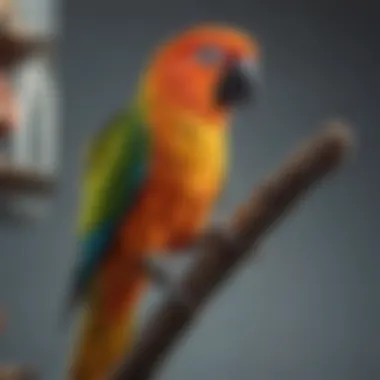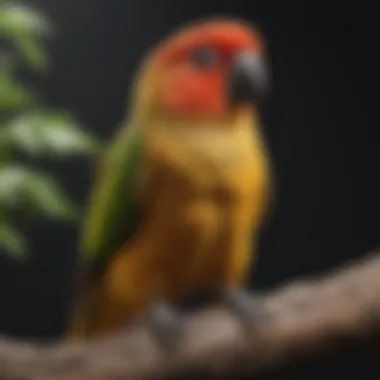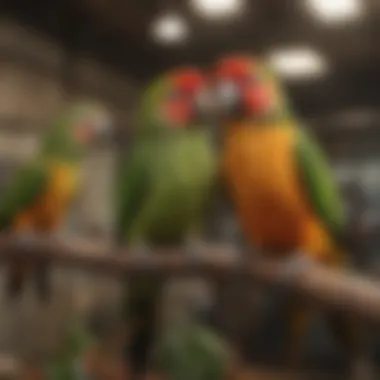The Ultimate Guide to Choosing Perches for Conures


Intro
Choosing the right perches for your conures is key for their comfort and overall well-being. This guide investigates essential aspects of perching options, including materials, sizes, and placement within their cages. Owners often underestimate how the choice of perch can affect a bird's health and behavior. However, providing a well-considered setup can lead to a happier and healthier life for your feathered companions.
Care Tips
Daily Care Routines
It is important to establish a daily routine for your conures that includes checking their perches. This way, pets can remain comfortable. Regularly inspect the perches for wear and tear, which could lead to safety issues. If the wood becomes unstable or contaminated, remove it immediately.
Cage Setup and Maintenance
Placement of perches should allow conures to exercise their natural behaviors. Consider creating a multi-level setup to encourage climbing and exploration. Use perches of varying sizes and textures to promote foot health. New pet owners often overlook how lighting affects the environment - provide sunlight and avoid direct drafts.
Hygiene and Cleaning Practices
Maintaining hygiene is essential for preventing disease. Clean perches often to ensure the habitats remain free from bacteria and parasites. You can use mild, bird-safe detergents and allow thorough drying before adding perches back to the cage. Additionally, a wipe down of surrounding areas can keep the cage environment tidy.
Seasonal Care Adjustments
Watch for seasonal changes. In colder months, ensure that perch placement is warm and secure from drafts. Conures may need additional warmth during winter. In summer months, proper airflow can prevent overheating, so arrange perches to allow for ventilation. Monitoring humidity is also necessary because it can impact the birds’ health.
Behavioral Insights
Understanding Bird Body Language
Conures often use body language to communicate their feelings. A raised crest can indicate excitement while a puffed-up feather indicates possible stress or fear. Know how your conure expresses itself. It helps you to respond accordingly.
Common Behavioral Issues and Solutions
Behavioral issues, such as feather plucking or aggression, can stem from stress or environmental factors. Providing adequate perches can significantly minimize these issues. If your bird starts plucking, change perch textures or add distractions like toys.
Positive Reinforcement Techniques
Building trust is essential. Use positive reinforcement to encourage cooperative behaviors. Treat your conures when they perch in allocated spaces, further captivating their interest in chosen spots.
Social Interaction Needs
Conures are social birds and enjoy interacting with their owners and other birds. Spend time daily to engage with them. Rotate perching arrangements, as engaging activities provide stimulation which results in happier birds.
Nutrition Guides
Feeding your conures a well-balanced diet is crucial. Make sure to use suitable feeding techniques and educate yourself on their dietary needs.
Essential Diet Components
Seeds form an essential part of their diet, accompanied by fresh fruits and vegetables like carrots and apples. Understanding what foods contribute to their overall health is necessary.
Safe and Toxic Foods
Certain foods like chocolate and avocado may be toxic to birds. Refer to veterinary recommendations or reliable sources to find comprehensive lists of safe food options. Be careful in selecting snacks contrary can cause serious illness.
Supplements and Treats
Some conures may require calcium or multivitamin supplements to enhance their well-being. Consult a veterinarian to understand which might be necessary.
Feeding Strategies for Different Species
Consider their unique needs when evaluating feeding strategies. Different species of conures have different needs and preferences. Finding the right balance guides their nutrition.
Wellness and Health
Routine Health Checkups
Regular vet visits are important in tracking your conure's health. Many underlying issues can be avoided through preventive care.
Identifying Symptoms of Illness
Look for signs of illness, which may include lethargy, fluffed feathers, or unusual droppings. Early intervention can increase the chance of recovering for birds that show these signs.
Preventative Care and Vaccinations
Vaccinations for specific diseases relevant to your birds should not be overlooked. Following vaccination schedules ensures your pet remains protected from health risks.
Mental and Emotional Well-being


Conures thrive on mental engagement. Add engaging initiatives like stimulating toys or challenging activities to their cages. Positive mental health contributes directly to their overall health.
Enriching Activities
Toys and Playtime Ideas
To keep your conures engaged, incorporate a variety of toys. Materials like wood, cotton, and paper offer both interest and engagement.
Training and Tricks
Training sessions can create bonds. Start with simple tricks and expend to more complex actions as your bird learns. Patience is key in training.
Outdoor Activities and Interaction
Find safe ways to expose conures to outdoors. Harness training opens opportunities for adventure and interaction. Supervised outdoor time increases exploration - higher engagement leads to healthier birds.
DIY Projects for Mental Stimulation
Personalized strategies or projects like birdhouses or others can be rewarding to build. Creating enjoyable experiences invites interaction, thus enriching their environment.
Preamble to Conures
Conures are engaging and sociable birds, adored for their vibrant plumage and cycling personalities. They require proper care and an enriching environment to thrive. The selection and placement of perches play a critical role in their well-being. Having an understanding of conure behavior is beneficial. It helps to create a stimulating life for these feathered pets. In this article, we will explore different aspects of conure perches and their significance to these birds’ health and behavior.
Understanding Conure Behavior
Conures exhibit various behaviors that reflect their energetic and curious nature. They are known for head bobbing, chirping, and mimicking sounds. Understanding these actions can help owners respond appropriately to their pet's needs. For instance, social interaction is crucial for conures. They crave interaction, whether it is through toys, other birds, or their human companions. Learning to recognize when a conure seeks attention can guide owners on timing for mental stimulation.
Conures also have specific comfort needs. They enjoy exploring different surfaces and heights. This behavior highlights the importance of offering suitable perches. Conures like to climb and even play on their perches. It becomes essential to provide varied textures and sizes of perch to maintain their interest and boost well-being.
The Role of Perches in Conure Environments
Perches serve vital purposes in the lives of conures beyond mere resting spots. These items directly impact their health and behavior. Adequate perch selection contributes to better foot health. Birds can develop foot problems if they have to stand on improper surfaces for extended periods.
Moreover, the perch placements affect the social dynamics of the environment. Conures appreciate options. They often choose a vantage point to monitor their surroundings. This natural behavior indicates their need for safety and comfort, making multi-level perches highly desirable. Giving them various perch locations encourages their exploratory nature.
In essence, perches are not just accessories within the cage. They influence a conure’s daily behavior significantly. The comfort, security, and opportunities for natural behaviors make it necessary for owners to thoughtfully consider their aviary setup.
A well-structured environment contributes to the overall health and happiness of conures, allowing them the flexibility they naturally seek.
Choosing the Right Perch Material
Choosing the right material for conure perches is fundamental in creating a comfortable and safe living space for these intelligent birds. The material can significantly impact a bird's health and behavior. Each type of perch material has its own benefits and considerations.
Wooden Perches
Benefits of Natural Wood
Natural wood perches are favored by many bird keepers. They offer several advantages that contribute to the well-being of conures. One key characteristic is their natural texture, which can help in maintaining foot health. Natural wood allows birds to grip securely, essential for preventing foot problems like bumblefoot. Moreover, many conures enjoy chewing on wooden perches, giving them mental stimulation.
There might be some concerns with wood perches. For instance, proper selection of suitable wood type is crucial. Poorly chosen wood can be harmful due to chemicals or toxic substances. However, when correctly sourced, wood serves as a beneficial choice for both health and comfort.
Types of Wood Safe for Conures
Certain woods are well-known for being safe for conures. Some common types include pine, willow, and manzanita. Each type has unique features ensuring safety and enjoyment for your birds. Pine is lightweight and easy to clean but should be free of chemicals. Willow is very appealing due to its texture, while manzanita is sturdy, making it less prone to wear.
It's important to remember that not all wood is safe. For example, cedar should be avoided due to its toxic nature. Ensuring that the wood is untreated and clean is essential while opting for natural materials.
Plastic Perches
Advantages and Disadvantages
Plastic perches come with their unique aspects that can complement a bird's environment. One significant advantage is the ease of cleaning. Unlike natural wood, plastic can be washed without degrading in quality. This fact contributes to overall hygiene in the bird's living space.
However, there are disadvantages to consider. Some plastic perches do not provide enough grip, affecting the foot health of conures. Additionally, birds can peck at certain types of plastic, leading to potential hazards. Thus, selecting the best type of plastic, which retains balance between safety and easy honey, is crucial for a suitable perch selection.
Best Practices for Use
When using plastic perches, observing certain best practice protocols might be beneficial. Ensure the perches are securely fixed to prevent movement when birds land. Regular checks for gaps or structural issues can help maintain safety. Place the plastic perches in areas where birds can get enough light but are also detectable from the main feeding spots.
Determining the right usage can contribute significantly to comfort and functionality. Regular inspections help ensure that the perks are providing good grip and not degrading over time.
Metal Perches
Safety Considerations
Metal perches can be another viable option for conures. However, being aware of certain safety considerations is essential. One of the most notable aspects is ensuring that the metal does not have toxic coatings. Stainless steel varieties are generally recommended since they are durable and easy to clean. Such materials reduce the risk of rust developing over time, which ensures safety.


That said, if improperly cleaned, metals can harbor bacteria. Surveillance of the condition of metal perches is necessary to avoid risks associated with uncleaned surfaces. Following proper cleaning routines is a key to their safe usage.
Maintenance Requirements
Maintenance for metal perches can be simpler due to fewer concerns surrounding fading or cracking. It's essential to establish a lightweight maintenance kit for cleaning purposes. Instruments like soft cloths and bird-safe cleaning solutions can keep metal surfaces shiny and hygienic. Being vigilant for signs of corrosion or rough patches ensures longevity.
Regular maintenance leads to an overall better experience for both the birds and their keepers. Tracking how often to clean based on usage and placement can extend the life of a metal perch. Easy cleaning removes many potential dangers, making them an efficient choice within the bird’s environment.
Perch Size and Shape
The size and shape of perches play a crucial role in the overall health and comfort of conures. It is important that the perches provided fit well within their environment and accommodate the diverse physical attributes of these birds. An appropriately sized and shaped perch promotes ease of movement and helps prevent foot injuries, enhancing the quality of life for your conure.
Determining Appropriate Diameter
Effects on Foot Health
The diameter of the perch has a significant impact on foot health for conures. Birds require diverse diameters to maintain good muscle strength in their feet. A perch that is too large may cause unnecessary strain, while one that is too small can lead to pressure points, which might even develop into bumblefoot. ф observado how foot health is often overlooked, leading to potential medical issues. Selecting the correct diameter not only helps in preventing these conditions but also improves the overall well-being of your feathered friend.
Recommended Size Ranges
When considering perch size, one must pay close attention to the recommended size ranges. For conures, ideal diameter falls between one-quarter inch to one inch. This range is considered beneficial as it suits the different leg sizes in conures and provides the necessary grip. A perch that is consistent in its size across a range promotes positive interaction and overall comfort, preventing injuries and achieving proper foot support.
Variations in Shape
Straight vs.
Curved
The shape of a perch can also considerably influence a conure's well-being. Straight perches provide stable footing for birds during rest. Conversely, curved perches facilitate stretching and enhance balance skills, contributing to muscular development in their feet and legs. Curved perches can also address behavioral patterns—conures who engage with varied shapes tend to stimulate both mental and physical challenges. Thus, having a mix of both shapes yields beneficial activities without imposing hurdles.
Importance of Texture
Finally, the texture of perches merits attention. A coarse or irregular surface encourages healthy foot scratches and good grip, mimicking natural environments. Providing multiple textures as part of a versatile perch setup can keep a conure mentally stimulated. Birds naturally seek out varying surface options, and spikes or ridges can also aid in gripping, giving more confidence as they navigate different surfaces. Texture, therefore, acts not only in aesthetics but in practical function to encourage healthy habits for conures.
Placement of Perches
Understanding the optimal placement of perches is crucial for creating a healthy environment for conures. It greatly influences their comfort, behavior, and access to essential resources. A well-thought-out layout does not just look good; it caters to the specific needs of these vibrant birds. For conures, perch placement can determine their overall well-being.
To maximize your pet's experience, the following aspects are vital to consider when placing perches:
- Safety: Ensure perches are secured and will not fall. A safe environment encourages exploration and reduces stress.
- Accessibility: Conures should be able to access their perch without effort. Birds have different levels of agility. Adjust the heights based on the abiliy of your bird.
- Variety in Positioning: Different heights and orientation enhance physical activity. Birds naturally seek out high places. Having various setups stimulates their natural instincts.
Thus, analyzing angles, surfaces, and angles in detail assists in configuring an ideal environment.
Vertical and Horizontal Setup
The vertical and horizontal setup plays a significant role in establishing a thriving environment for conures. Each setup offers unique benefits that serve different behavioral and physical needs.
Vertical Setup
A vertical coop provides ample climbing opportunities that are essential for physical fitness. Conures often prefer to perch higher up; therefore, placing sturdy perches at different heights mimics an enriched habitat. Here are key points to consider:
- Natural Behavior: Conures naturally climb in the wild. A vertical layout encourages this acute behavior, ensuring that they maintain agility.
- Social Dynamics: Higher perches can allow dominant interfacing while lower ones invite active interaction, creating a stimulating atmosphere where social dynamics unfold.
Horizontal Setup
Horizontal placement addresses comfort and practicality. perches placed horizontally serve the following functions:
- Resting Areas: Wider and sturdier horizontal surfaces provide relaxing zones for your birds to recuperate after fun sessions of climbing.
- Strengthening Bonds: Placing perches closer together can invite chirping whispers or gentle social interactions between conures, which fosters better bonds.
Distance from Food and Water
The proximity of perches to food and water is paramount for maintaining health. Birds have needs that must be fulfilled efficiently.
- Access to Nutrition: Ensure that their perch enables easy reach to food and water. Distance that requires extensive movement can instigate frustration.
- Hydration: Adequate hydration is crucial. Arrange the perches so drinkers are also easily accessible.
- General Well-Being: Limiting the number of navigations will alleviate numerous unnecessary flights back and forth. Habitual unavailability of food or water can lead to distress prolonging essential for healthy behavior.
By observing all these arrangements, you can optimize your conures’ living space for easier navigating. Thoughtful perch placements simplify daily experiences enriching quality of life significantly.
Integrating Natural Perches
Integrating natural perches into a conure's living environment is vital for their physical and mental well-being. This approach relies on materials that mimic the bird’s natural habitat, allowing for a richer and more stimulating environment. Natural perches also encourage conures to engage in their instinctual behaviors, promoting exercise, exploration, and socialization. The choice of these perches can affect their overall health and happiness.
Using Branches and Twigs
Creating perches from branches and twigs is one effective way to use natural elements in a bird's cage. It provides not only comfort but also an interesting texture for their feet. This can lead to engaging behaviors as conures climb, explore, and interact with their perches.
Selecting Safe Species


When selecting branches and twigs for perches, it is crucial to choose safe species for your conures. Unsafe wood can harbor toxins harmful to birds. Ideal choices include:
- Apple
- Willow
- Maple
The primary characteristic of these trees is their safety for consumption and durability. Choosing these species helps prevent the risk of ingesting harmful materials. They provide structure and comfort since they are naturally appealing.
Benefits of Natural Elements
The main benefits of integrating natural elements into a conure’s environment are numerous. First, they promote healthy foot usage and prevent issues such as bumblefoot, a common ailment in pet birds that is related to poor perch choices. Furthermore, natural wood differs from synthetic materials in texture, offering a natural gripping surface that is essential for their balance and agility. It enriches their foraging instincts since it may retain bark and other organic materials.
Creating a Varied Environment
Creating a varied environment is essential when integrating natural perches. By supplementing with different heights, thicknesses, and textures, birds can develop strong leg muscles. It also appeals to their exploring nature. In a home setting, variations could include branches from different species, large rope perches, or even perches made from untreated pine. Providing a diverse range of options ultimately supports emotional and physical stimulation, enhancing their daily life.
"A stimulating environment fosters healthy behaviors, keeping pets active and engaged, which is fundamental for their mental health."
Safety Considerations for Perches
Safety is a crucial element when selecting perches for conures. Understanding the materials and conditions of perches can help prevent accidents or health issues. Conures are curious and active birds. Therefore, ensuring that perches are safe contributes not only to their wellbeing but also allows them to explore their environment without harm.
Evaluating Perch Conditions
The evaluation of perch conditions starts with examining the surface and structure of the perch. A rough or uneven surface can lead to injuries. It's important to check for sharp edges or splinters that may cause cuts or scratches on the birds' feet.
Consider these aspects:
- Material Integrity: Check that materials like wood or plastic are not degraded or deteriorating.
- Surface Consistency: Make sure that the ochy coating is smooth.
- Stability: The perch should be sturdy and securely installed to avoid wobbling during use.
Regular inspections can catch minor issues before they develop into significant problems, ensuring a safe space for your conures to perch.
Potential Dangers to Avoid
Many perches come with risks if not carefully managed. Awareness of potential hazards is crucial in providing a safe habitat for conures.
Important: Regular checks are vital in maintaining perch safety!
Consider the following dangers:
- Toxic Material: Perches made from unsafe woods like cedar or treated materials can release harmful chemicals.
- Size Mismatches: Perches that are too thick or small can cause foot discomfort or injury. Conures benefit from a variety of perch sizes.
- Inadequate Cleaning: Dirt accumulation can lead to bacterial growth, posing health risks to birds.
- Close Proximity to Cages: Positioning perches too near cage bars or corners may limit the birds' movement and trigger stress.
By taking these considerations seriously and carefully selecting and maintaining perches, owners can ensure their conures have a safe and enjoyable living environment.
Maintenance of Perches
Maintaining perch hygiene and safety is vital for conure health. Dirty or unsafe perches can lead to various health issues, including infections or foot problems. Regular maintenance of perches not only promotes a clean environment but also contributes to the physical well-being of conures. Establishing routines for both cleaning and inspecting your perches is an easy way to ensure that your feathered friends remain comfortable and healthy.
Cleaning and Hygiene Protocols
Cleaning perches is a necessary routine that every bird owner must prioritize. Feces, food debris, and residues accumulate, potentially leading to bacterial growth.
Step-by-step procedures include:
- Remove all perches. Start with taking them out of the cage to avoid scattering waste.
- Soak and scrub. Use warm water and bird-safe soap for thorough cleaning of wooden and plastic perches. For metal, a vinegar solution works well.
- Rinse and dry properly. It’s essential to remove all soap; any remaining can be harmful to conures.
- Wash cage surroundings. Spend a few extra minutes inspecting corner areas where debris might collect.
In addition to regular deep cleaning, daily spot checks are also useful. You may wish to wipe down surfaces with a damp cloth, minimizing germ spread and accumulation. This eases workload and keeps up with hygiene filters.
Inspecting for Wear and Tear
Every perch takes a toll over time; therefore vigilance in spotting signs of damage is key. An unaddressed defect can result in injuries, while a degraded perch can harbor pathogens.
Points to consider during inspections are:
- Surface examination. Look for cracks, splintering, or chipping, any of which can harm your conure’s feet.
- Stability check. Ensure that the perches fit securely and do not wobble during use.
- Material review. Adjust or change items that display signs of wear, particularly perches made of natural wood which can decay.
In each instance, ensure identification markers are clear regarding when the last inspection was made. Observing ply and adjusting as necessary further enhances your conure’s safe roosting.
Taking time for thorough cleaning and regular inspections is not just a chore; it shows care and promotes the well-being of your precious conures.
Culmination
Understanding the significance of perch selection for conures is crucial for every conure owner. The right perches can greatly affect the well-being, activity levels, and overall happiness of these intelligent birds. In this article, we have delved into several factors that essential in deciding the appropriate perches for your feathered friends.
Proper perch choices not only enhance the comfort of your conure but also contribute to their developmental needs.
Recap of Key Points
Throughout this comprehensive guide, we have explored key aspects relating to perches:
- The importance of material choices, including wood, plastic, and metal perches.
- Recommended temperature and safety practices.
- Considerations surrounding perch size and shape.
- Insights on strategic perch placement.
- Maintenance routines that ensure cleanliness and durability.
- Health benefits arising from natural elements like branches and twigs.
Encouragement for Informed Choices
It is vital for pet bird owners to make well-informed decisions regarding perch selections. Consult with avian specialists or do thorough research. Making the right choices can lead to measurable benefits. This includes fostering natural behaviors and enhancing overall bird health. Always remember, the wrong perch may cause stress or harm. Your conure deserves the best to thrive. By investing in quality perch setups, you ensure a fulfilling life for your pet bird.















